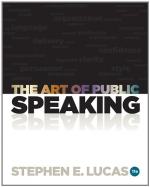You will find it excellent practise, both for memory and delivery, to commit the specimen speeches found in this volume and declaim them, with all attention to the principles we have put before you. William Ellery Channing, himself a distinguished speaker, years ago had this to say of practise in declamation:
“Is there not an amusement, having an affinity with the drama, which might be usefully introduced among us? I mean, Recitation. A work of genius, recited by a man of fine taste, enthusiasm, and powers of elocution, is a very pure and high gratification. Were this art cultivated and encouraged, great numbers, now insensible to the most beautiful compositions, might be waked up to their excellence and power.”
Speaking from Notes
The third, and the most popular method of delivery, is probably also the best one for the beginner. Speaking from notes is not ideal delivery, but we learn to swim in shallow water before going out beyond the ropes.
Make a definite plan for your discourse (for a fuller discussion see Chapter XVIII) and set down the points somewhat in the fashion of a lawyer’s brief, or a preacher’s outline. Here is a sample of very simple notes:
ATTENTION
I. INTRODUCTION.
Attention indispensable to the performance
of any
great work. Anecdote.
II. DEFINED AND ILLUSTRATED.
1. From common observation.
2. From the lives of great men {Carlyle, Robert E. Lee.}
III. ITS RELATION TO OTHER MENTAL POWERS.
1. Reason.
2. Imagination.
3. Memory.
4. Will. Anecdote.
IV. ATTENTION MAY BE CULTIVATED.
1. Involuntary attention.
2. Voluntary attention. Examples.
V. CONCLUSION.
The consequences of inattention and of attention.
Few briefs would be so precise as this one, for with experience a speaker learns to use little tricks to attract his eye—he may underscore a catch-word heavily, draw a red circle around a pivotal idea, enclose the key-word of an anecdote in a wavy-lined box, and so on indefinitely. These points are worth remembering, for nothing so eludes the swift-glancing eye of the speaker as the sameness of typewriting, or even a regular pen-script. So unintentional a thing as a blot on the page may help you to remember a big “point” in your brief—perhaps by association of ideas.
An inexperienced speaker would probably require fuller notes than the specimen given. Yet that way lies danger, for the complete manuscript is but a short remove from the copious outline. Use as few notes as possible.
They may be necessary for the time being, but do not fail to look upon them as a necessary evil; and even when you lay them before you, refer to them only when compelled to do so. Make your notes as full as you please in preparation, but by all means condense them for platform use.




